Mechanical Properties of Al Matrix Composite Enhanced by In Situ Formed SiC, MgAl2O4, and MgO via Casting Process
Abstract
1. Introduction
2. Materials and Methods
2.1. Materials
2.2. Casting Process
2.3. Test
3. Results and Discussion
3.1. Phase Evolution and Reactions in In Situ Growth Process Based on Flash Pyrolysis Mode
3.2. The Microstructure Evolution
3.3. Mechanical Properties
3.4. Failure Analysis
4. Conclusions
- The nanosized 3C–SiC, MgAl2O4, and MgO grains were formed in the Al–Mg–Si matrix alloy by in situ growth process in flash pyrolysis mode. The resin pyrolysis in the molten alloy decreased the oxide slag but increased the pore in the alloy matrix.
- These ceramic grains scattered in the alloy were homogenous and enhanced the mechanical strength. Except for the tensile strength, the bending and compression strength was increased under the high resin addition.
- The tensile strength was 142.6 ± 3.5 MPa, and the maximum bending strength and compression strengths were 378.2 MPa and 299 MPa in the 1.5% resin-added samples, which improved to 126.9 and 121.3%, respectively.
- The lath-shaped Si was the primary effect factor of the mechanical properties. The failure mechanism was controlled by the transcrystalline rupture.
Author Contributions
Funding
Institutional Review Board Statement
Informed Consent Statement
Data Availability Statement
Acknowledgments
Conflicts of Interest
References
- Dong, L.L.; Mi, G.F.; Li, C.Y.; Xu, L.; Wei, J.J. Effects of SiC Particle Volume Fraction on Microstructure and Mechancial Properties of SiCp/6061Al Composites. Integr. Ferroelectr. 2020, 210, 215–226. [Google Scholar] [CrossRef]
- Laurent, V.; Chatain, D.; Eustathopoulos, N. Wettability of SiC by aluminium and Al-Si alloys. J. Mater. Sci. 1987, 22, 244–250. [Google Scholar] [CrossRef]
- Bao, S.; Tang, K.; Kvithyld, A.; Engh, T.; Tangstad, M. Wetting of pure aluminium on graphite, SiC and Al2O3 in aluminium filtration. Trans. Nonferr. Met. Soc. China 2012, 22, 1930–1938. [Google Scholar] [CrossRef]
- Yadav, S.; Gangwar, S.; Singh, S. Micro/Nano Reinforced Filled Metal Alloy Composites: A Review Over Current Development in Aerospace and Automobile Applications. Mater. Today Proc. 2017, 4, 5571–5582. [Google Scholar] [CrossRef]
- Singh, J. Fabrication characteristics and tribological behavior of Al/SiC/Gr hybrid aluminum matrix composites: A review. Friction 2016, 4, 191–207. [Google Scholar] [CrossRef]
- Xie, J.-F.; Liu, T.-S.; Li, Q.; Li, Q.-Y.; Xu, Z.-H.; Qiu, F.; Tang, J.; Yang, H.-Y.; Jiang, Q.-C. Nanoparticulate dispersion, microstructure refinement and strengthening mechanisms in Ni-coated SiCp/Al-Cu nanocomposites. Mater. Sci. Eng. A 2019, 762, 138092. [Google Scholar] [CrossRef]
- Dong, C.-G.; Cui, R.; Wang, R.-C.; Peng, C.-Q.; Cai, Z.-Y. Microstructures and mechanical properties of Al 2519 matrix composites reinforced with Ti-coated SiC particles. Trans. Nonferr. Met. Soc. China 2020, 30, 863–871. [Google Scholar] [CrossRef]
- Mohamadigangaraj, J.; Nourouzi, S.; Aval, H.J. Microstructure, mechanical and tribological properties of A390/SiC composite produced by compocasting. Trans. Nonferr. Met. Soc. China 2019, 29, 710–721. [Google Scholar] [CrossRef]
- Kanth, U.R.; Rao, P.S.; Krishna, M.G. Mechanical behaviour of fly ash/SiC particles reinforced Al-Zn alloy-based metal matrix composites fabricated by stir casting method. J. Mater. Res. Technol. 2019, 8, 737–744. [Google Scholar] [CrossRef]
- Khdair, A.I.; Fathy, A. Enhanced strength and ductility of Al-SiC nanocomposites synthesized by accumulative roll bonding. J. Mater. Res. Technol. 2020, 9, 478–489. [Google Scholar] [CrossRef]
- Baazamat, S.; Borhani, E.; Tajally, M. The correlation of microstructure, recrystallization texture and mechanical properties with second-phase content in Al/WO3/SiC hybrid nanocomposite during ARB process. Mater. Sci. Eng. A Struct. Mater. Prop. Microstruct. Process. 2020, 798, 140060–140068. [Google Scholar] [CrossRef]
- Herzallah, H.; Elsayd, A.; Shash, A.; Adly, M. Effect of carbon nanotubes (CNTs) and silicon carbide (SiC) on mechanical properties of pure Al manufactured by powder metallurgy. J. Mater. Res. Technol. 2020, 9, 1948–1954. [Google Scholar] [CrossRef]
- Sudha, G.T.; Stalin, B.; Ravichandran, M.; Balasubramanian, M. Mechanical Properties, Characterization and Wear Behavior of Powder Metallurgy Composites—A Review. Mater. Today Proc. 2020, 22, 2582–2596. [Google Scholar] [CrossRef]
- Lee, K.-B.; Yoo, S.-H.; Kim, H.-S.; Won, S.-O.; Yang, B.-J.; Ahn, J.-P.; Choi, H.-J. Nitridation-assisted Al infiltration for fabricating Al composites. J. Mater. Sci. 2017, 52, 4333–4344. [Google Scholar] [CrossRef]
- Liao, J.; Chen, Z.; Li, B.; Liu, J.; Guan, T.; Yu, S.; Tang, K.; Wu, Q.; Wang, Y. Microstructure and mechanical properties of C /SiC–Al composites fabricated by PIP and vacuum pressure infiltration processes. J. Alloy. Compd. 2019, 803, 934–941. [Google Scholar] [CrossRef]
- Arthanari, S.; Li, Y.; Nie, L.; Guan, Y.; Yang, S. Microstructural evolution and properties analysis of laser surface melted and Al/SiC cladded magnesium-rare earth alloys. J. Alloy. Compd. 2020, 848, 156598–156613. [Google Scholar] [CrossRef]
- Riquelme, A.; Rodrigo, P.; Escalera-Rodriguez, M.D.; Rams, J. Additively Manufactured Al/SiC Cylindrical Structures by Laser Metal Deposition. Materials 2020, 13, 3331. [Google Scholar] [CrossRef] [PubMed]
- Tailor, S.; Sharma, V.K.; Mohanty, R.M.; Soni, P.R. Microstructure, Adhesion and Wear of Plasma Sprayed AlSi-SiC Composite Coatings. J. Surf. Eng. Mater. Adv. Technol. 2012, 02, 227–232. [Google Scholar] [CrossRef]
- Leszczyńska-Madej, B.; Garbiec, D.; Madej, M. Effect of sintering temperature on microstructure and selected properties of spark plasma sintered Al-SiC composites. Vacuum 2019, 164, 250–255. [Google Scholar] [CrossRef]
- Wu, C.; Gao, T.; Sun, Q.; Liu, G.; Du, X.; Liu, X. A novel method of coating ex-situ SiC particles with in-situ SiC interlayer in Al-Si-C alloy. J. Alloy. Compd. 2018, 754, 39–47. [Google Scholar] [CrossRef]
- Jiao, Y.; Zhu, J.; Li, X.; Wang, F.; Zhao, X.; Shi, C.; Abdul, W.; Lu, B. In-situ synthesis, microstructure and mechanism of SiC/Al–Mg–Si composites: Effects of Mg addition. Ceram. Int. 2020, 46, 17675–17683. [Google Scholar] [CrossRef]
- Nirala, A.; Soren, S.; Kumar, N.; Dwivedi, V.K.; Kaushal, D.R. A comprehensive review on stir cast Al-SiC composite. Mater. Today Proc. 2020, 21, 1610–1614. [Google Scholar] [CrossRef]
- Dhoria, S.H.; Durga Prasada Rao, V.; Venkata Subbaiah, K. Mechanical and wear behaviour of 6351 Al/Gr/SiC composites fabricated by squeeze casting. Mater. Today Proc. 2019, 18, 2107–2113. [Google Scholar] [CrossRef]
- Wang, F.; Yao, D.; Xia, Y.; Zuo, K.; Xu, J.; Zeng, Y. Porous SiC ceramics prepared via freeze-casting and solid state sintering. Ceram. Int. 2016, 42, 4526–4531. [Google Scholar] [CrossRef]
- Li, J.; Li, F.; Wu, S.; Lü, S.; Guo, W.; Yang, X. Variation of microstructure and mechanical properties of hybrid particulates reinforced Al-alloy matrix composites with ultrasonic treatment. J. Alloy. Compd. 2019, 789, 630–638. [Google Scholar] [CrossRef]
- Du, X.; Gao, T.; Liu, G.; Liu, X. In situ synthesizing SiC particles and its strengthening effect on an Al–Si–Cu–Ni–Mg piston alloy. J. Alloy. Compd. 2017, 695, 1–8. [Google Scholar] [CrossRef]
- Du, X.; Gao, T.; Qian, Z.; Wu, Y.; Liu, X. The in-situ synthesis and strengthening mechanism of the multi-scale SiC particles in Al-Si-C alloys. J. Alloy. Compd. 2018, 750, 935–944. [Google Scholar] [CrossRef]
- Du, X.; Gao, T.; Li, D.; Wu, Y.; Liu, X. A novel approach to synthesize SiC particles by in situ reaction in Al–Si–C alloys. J. Alloy. Compd. 2014, 588, 374–377. [Google Scholar] [CrossRef]
- Kmita, A.; Benko, A.; Roczniak, A.; Frączek-Szczypta, A.; Holtzer, M. Pyrolysis of organic ester cured alkaline phenolic resin: Identification of products. J. Anal. Appl. Pyrolysis 2018, 129, 6–12. [Google Scholar] [CrossRef]
- Kumar, J.; Singh, D.; Kalsi, N.S.; Sharma, S.; Pruncu, C.I.; Pimenov, D.Y.; Rao, K.V.; Kapłonek, W. Comparative study on the mechanical, tribological, morphological and structural properties of vortex casting processed, Al–SiC–Cr hybrid metal matrix composites for high strength wear-resistant applications: Fabrication and characterizations. J. Mater. Res. Technol. 2020, 9, 13607–13615. [Google Scholar] [CrossRef]
- Shin, S.; Cho, S.; Lee, D.; Kim, Y.; Lee, S.B.; Lee, S.K.; Jo, I. Microstructural Evolution and Strengthening Mechanism of SiC/Al Composites Fabricated by a Liquid-Pressing Process and Heat Treatment. Materials 2019, 12, 3374. [Google Scholar] [CrossRef] [PubMed]
- Melaibari, A.; Fathy, A.; Mansouri, M.; Eltaher, M.A. Experimental and numerical investigation on strengthening mechanisms of nanostructured Al-SiC composites. J. Alloy. Compd. 2019, 774, 1123–1132. [Google Scholar] [CrossRef]


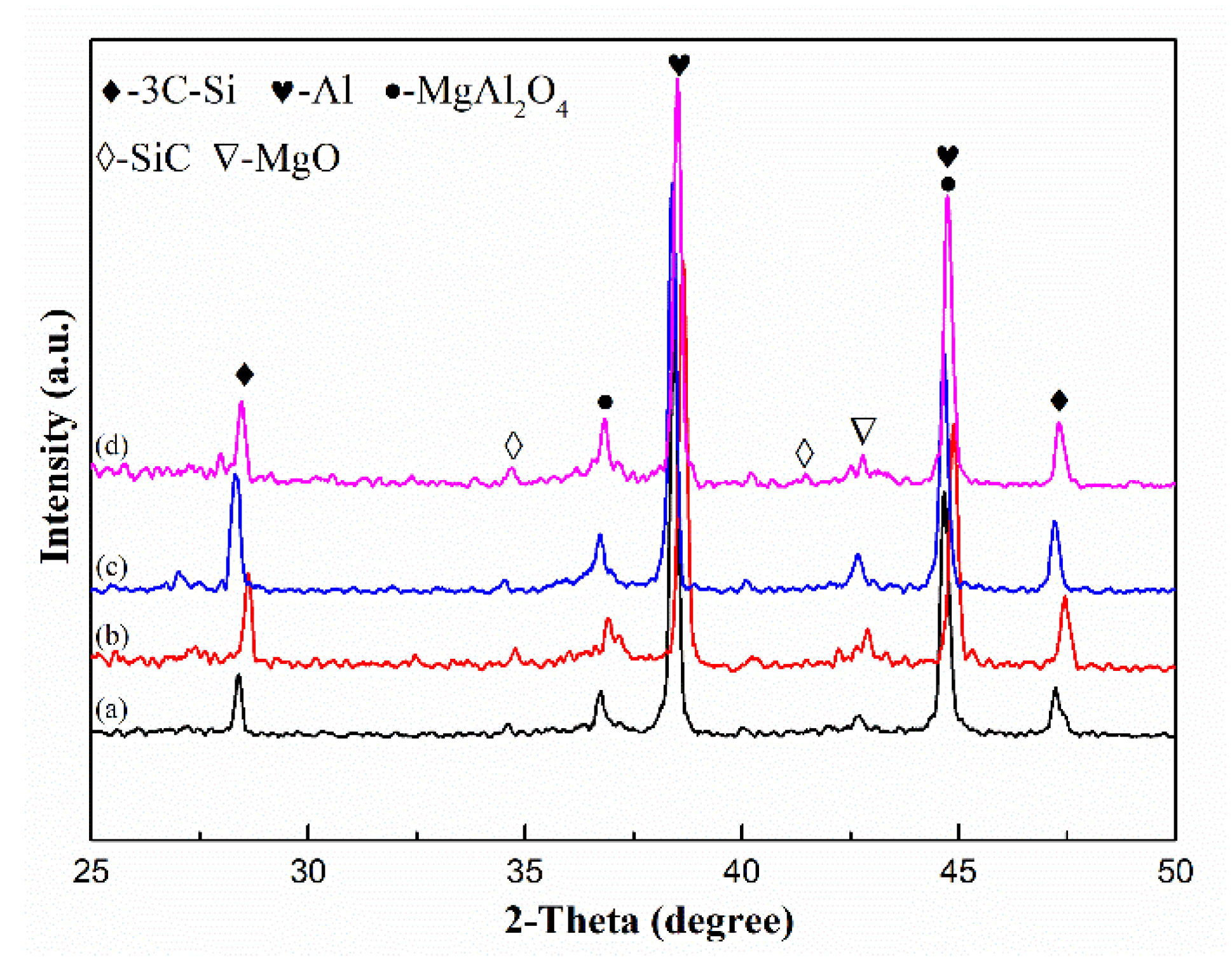
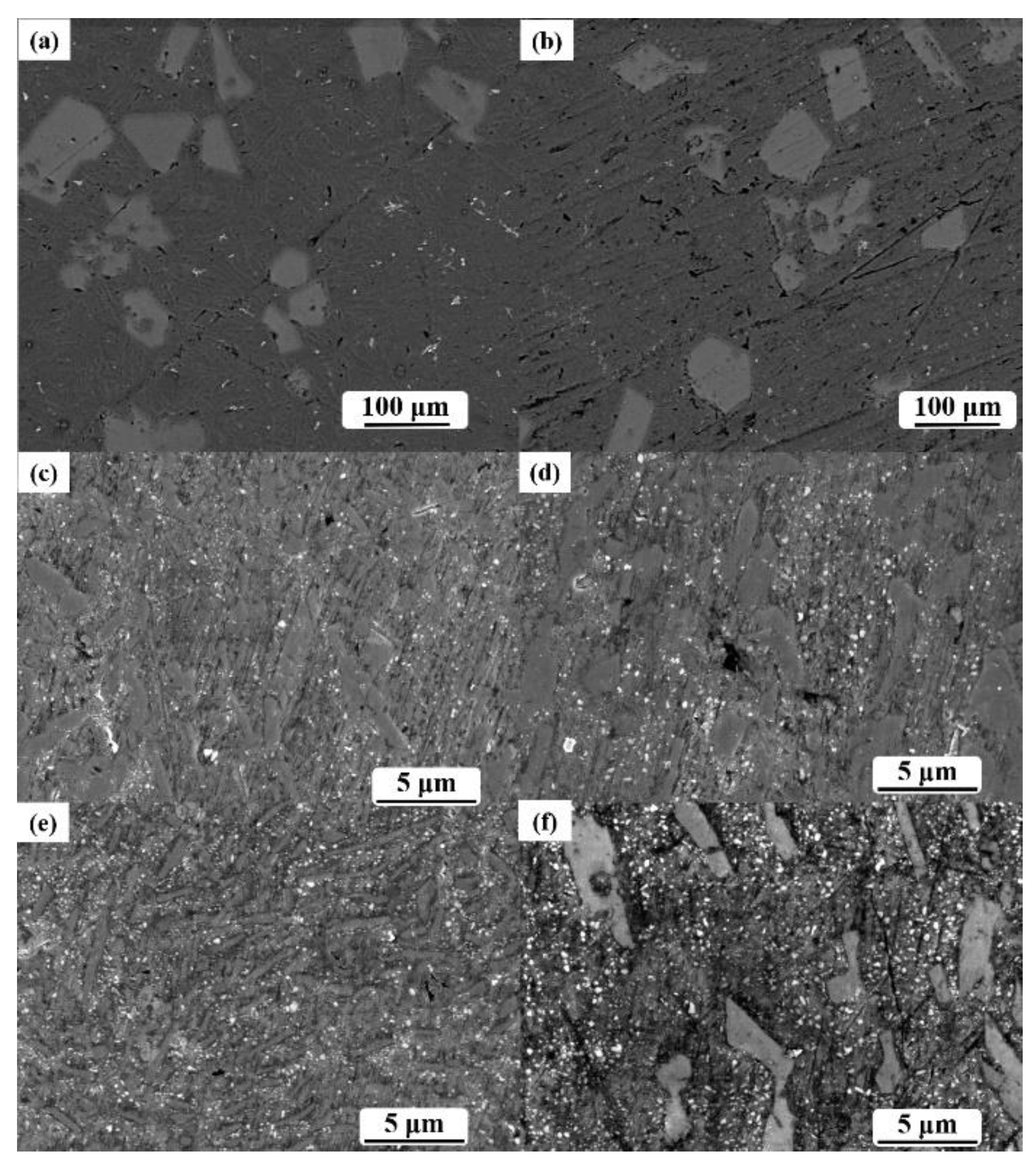
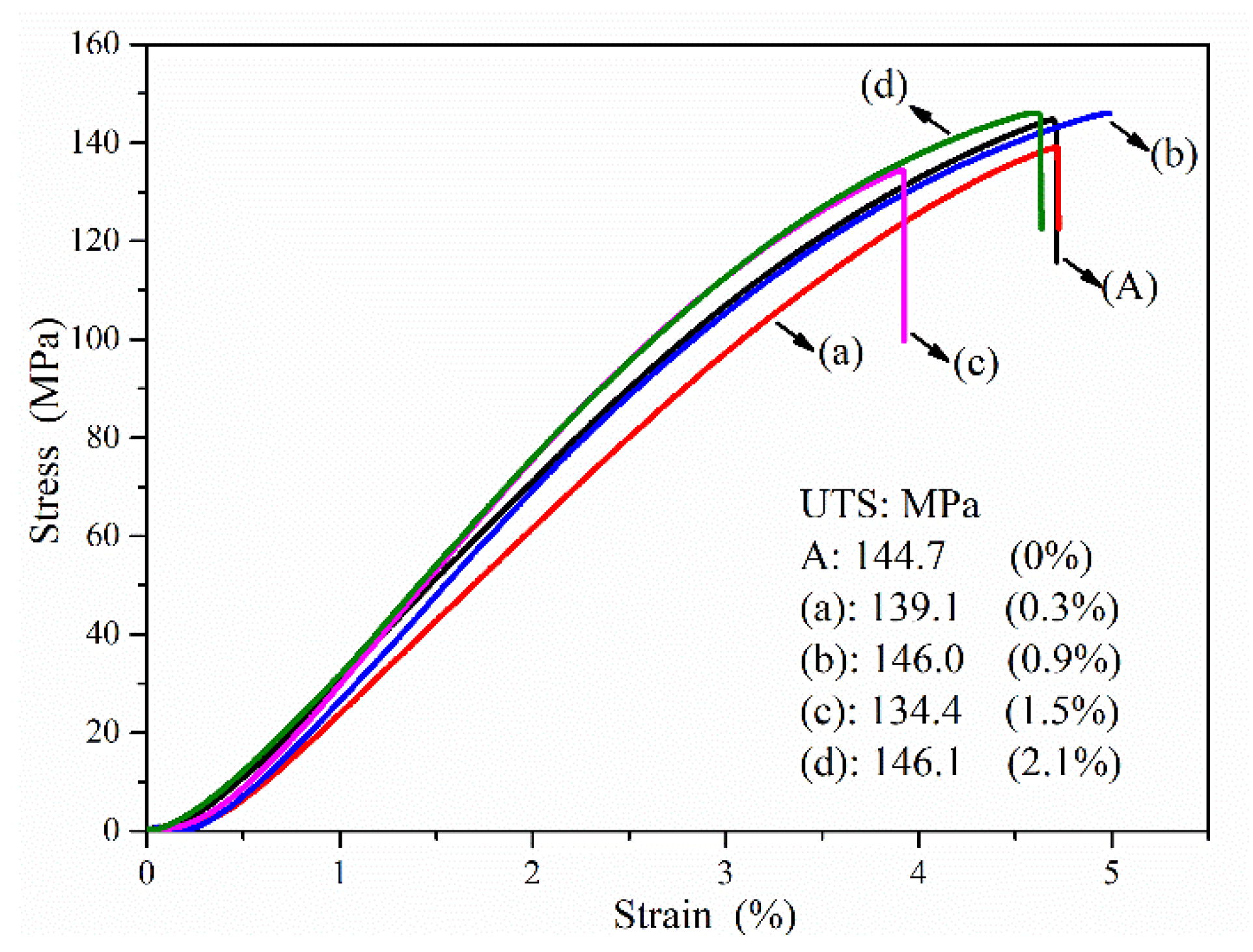
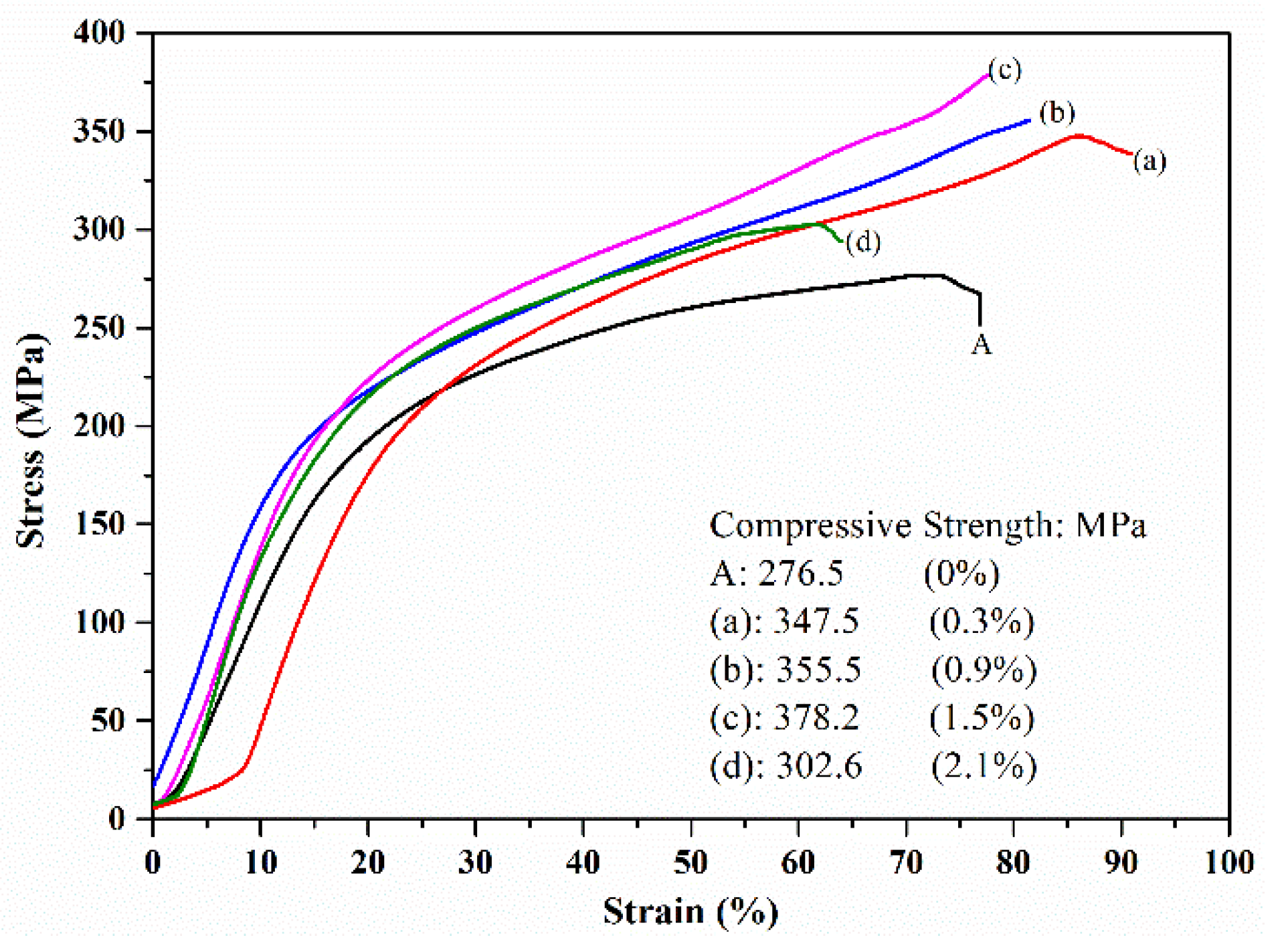
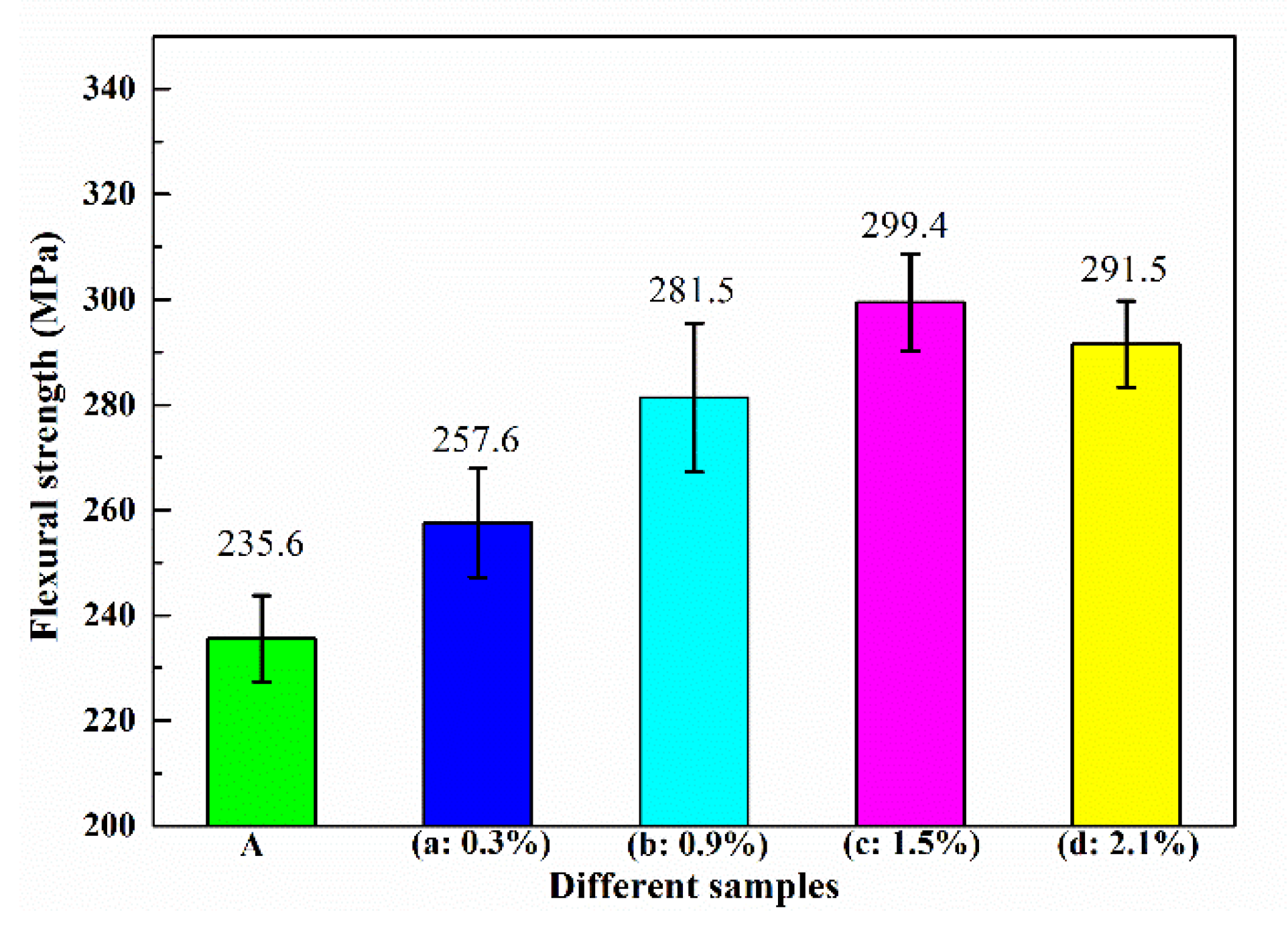
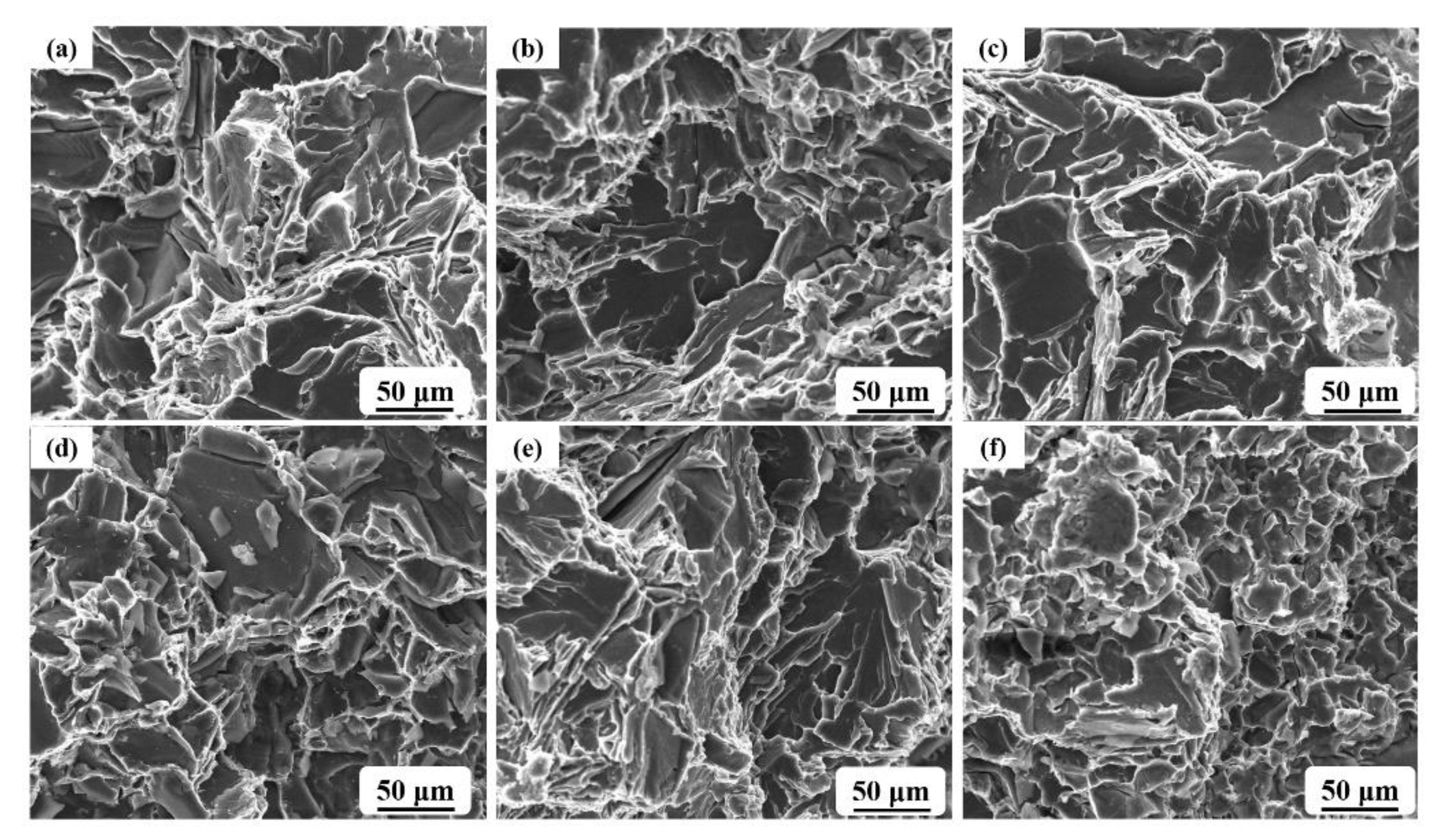
| Elements | Mg | Si | Ti | B | Al |
|---|---|---|---|---|---|
| Contents | 5 | 25 | 0.02–0.06 | <0.01 | Bal. |
| No. | Reactions | ΔrG (kJ) |
|---|---|---|
| 1 | Al + 1/2Mg + 2H2O (g) = 1/2MgAl2O4 + 2H2 (g) | −357.05 |
| 2 | Al + 1/2Mg + 2CO (g) = 1/2MgAl2O4 + 2C | −320.96 |
| 3 | Al + 1/2Mg + CO2 (g) = 1/2MgAl2O4 + C | −338.49 |
| 4 | Al + 1/2Mg + 2C6H6O (g) = 1/2MgAl2O4 + 12C + 6H2 (g) | −1035.51 |
| 5 | Al + 1/2Mg + 2C7H8O (g) = 1/2MgAl2O4 + 14C + 8H2 (g) | −1202.49 |
| 6 | Al + 1/2Mg + 2C8H10O (g) = 1/2MgAl2O4 + 16C + 10H2 (g) | −1327.73 |
| 7 | Mg (l) + C6H6O (g) = MgO + 6C + 3H2 (g) | −605.79 |
| 8 | Mg (l) + C7H8O (g) = MgO + 7C + 4H2 (g) | −689.28 |
| 9 | Mg (l) + C8H10O (g) = MgO + 8C + 5H2 (g) | −762.77 |
| 10 | Si (l) + 1/5C6H6O (g) =SiC + 3/5H2 (g) + 1/5CO (g) | −153.03 |
| 11 | Si (l) + 1/6C7H8O (g) = SiC + 2/3H2 (g) + 1/6CO (g) | −155.04 |
| 12 | Si (l) + 1/7C8H10O (g) = SiC + 5/7H2 (g) + 1/7CO (g) | −157.30 |
| 13 | Si (l) + 1/5C6H6 (g) = SiC + 3/5H2 (g) | −127.15 |
| 14 | Si (l) + 1/7C7H8 (g) = SiC + 4/7H2 (g) | −129.98 |
| 15 | Si (l) + 1/8C8H10 (g) = SiC + 5/8H2 (g) | −134.19 |
Publisher’s Note: MDPI stays neutral with regard to jurisdictional claims in published maps and institutional affiliations. |
© 2021 by the authors. Licensee MDPI, Basel, Switzerland. This article is an open access article distributed under the terms and conditions of the Creative Commons Attribution (CC BY) license (https://creativecommons.org/licenses/by/4.0/).
Share and Cite
Jiao, Y.; Zhu, J.; Li, X.; Shi, C.; Lu, B.; Wang, F.; Abdul, W. Mechanical Properties of Al Matrix Composite Enhanced by In Situ Formed SiC, MgAl2O4, and MgO via Casting Process. Materials 2021, 14, 1767. https://doi.org/10.3390/ma14071767
Jiao Y, Zhu J, Li X, Shi C, Lu B, Wang F, Abdul W. Mechanical Properties of Al Matrix Composite Enhanced by In Situ Formed SiC, MgAl2O4, and MgO via Casting Process. Materials. 2021; 14(7):1767. https://doi.org/10.3390/ma14071767
Chicago/Turabian StyleJiao, Yuhong, Jianfeng Zhu, Xuelin Li, Chunjie Shi, Bo Lu, Fen Wang, and Waras Abdul. 2021. "Mechanical Properties of Al Matrix Composite Enhanced by In Situ Formed SiC, MgAl2O4, and MgO via Casting Process" Materials 14, no. 7: 1767. https://doi.org/10.3390/ma14071767
APA StyleJiao, Y., Zhu, J., Li, X., Shi, C., Lu, B., Wang, F., & Abdul, W. (2021). Mechanical Properties of Al Matrix Composite Enhanced by In Situ Formed SiC, MgAl2O4, and MgO via Casting Process. Materials, 14(7), 1767. https://doi.org/10.3390/ma14071767





